Blog
A Sideways View
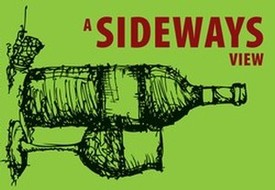 Remember the movie Sideways? This very popular movie, which came out in 2004, chronicles the journey of two middle-aged men -- a self-proclaimed wine expert and his soon-to-be-married actor friend -- through the Santa Ynez wine region. It changed the landscape of red wine, driving sales of Pinot Noir into the stratosphere while causing Merlot sales to plummet. As a Merlot lover, that movie always annoyed me, but I decided to revisit it since we recently released our Lily Rock 2009 Merlot and 2014 Vin Gris of Pinot Noir. There are a lot of great quotes in the movie, so I thought I’d have some fun with them and maybe even slay a few myths. So here we go …
Remember the movie Sideways? This very popular movie, which came out in 2004, chronicles the journey of two middle-aged men -- a self-proclaimed wine expert and his soon-to-be-married actor friend -- through the Santa Ynez wine region. It changed the landscape of red wine, driving sales of Pinot Noir into the stratosphere while causing Merlot sales to plummet. As a Merlot lover, that movie always annoyed me, but I decided to revisit it since we recently released our Lily Rock 2009 Merlot and 2014 Vin Gris of Pinot Noir. There are a lot of great quotes in the movie, so I thought I’d have some fun with them and maybe even slay a few myths. So here we go …
If you've seen the movie and know a bit about wine, you know Maya adores wine and everything she says about wine is true. What you may not know is that wine snob Miles is almost always wrong about wine.
Maya: I like how wine continues to evolve. Like if I opened a bottle of wine today, it would taste different than if I'd opened it on any other day, because a bottle of wine is actually alive. And it's constantly evolving and gaining complexity.
She’s right! Wine is a living, breathing thing. You might think that once wine is bottled, the biological process stops … almost, but not quite. A little oxygen enters through the cork, and even this minute amount is enough to allow the wine to age. It’s why I favor cork closures over plastic corks or screw-tops. The latter don’t allow any oxygen to be exchanged, and wine needs the internal chemical reaction with oxygen to gain complexity – it helps form long tannin chains, and the longer the chains, the smoother and mellower the wine.
Miles: (tasting the Estate Chardonnay at Byron Wines) Mmm, a little citrus ... maybe some strawberry ... passion fruit ... and, oh, there's just like the faintest soupçon of, like, asparagus and just a flutter of a, like a, nutty Edam cheese.
This quote always makes me laugh. When you get that vegetal, asparagus flavor, it means the grapes were not fully ripe at harvest. It’s definitely not something you want in your finished wine.
As far as the “nutty” component goes, that could be from malolactic fermentation. But when Miles adds the cheese reference, it clearly points to a bacterial problem -- probably Brettanomyces. Again, not desirable!
His reference to strawberries is also comical. Strawberry isn’t a component of any Chardonnay I've encountered, nor is it mentioned in the wine tasting notes for any of Byron's many Chardonnays.
Jack: If they want to drink Merlot, we're drinking Merlot.
Miles: No, if anyone orders Merlot, I'm leaving. I am NOT drinking any (BLEEPING) Merlot!
This quote between Miles and his un-wine-educated friend Jack is probably the most famous one in the movie. It set the stage for the rapid decline in sales for the previously popular Merlot. Tasting rooms everywhere began hearing wine visitors tell their pourers, “Give me anything, just not Merlot.”
Merlot is a fantastic grape. I love a well-made bottle of Merlot. It tends to be very smooth – it’s not in-your-face bold, and it’s not as acidic or tannic as other varietals. That's why I use Merlot as the base of our Meritage. Typically, 50% of the blend is Merlot, and the rest is Cabernet Franc and Cabernet Sauvignon. One time I varied this, and the Coyote Run blend was born. It, too, is half Merlot, but I blended it with some Petit Verdot and Malbec I had on hand at the time. I love to experiment, and the Coyote Run turned out great. It sold out quickly, but I’ll be bottling the 2012 vintage soon!
Jack: (pouring champagne while Miles drives on their first morning) Pinot Noir? Then how come it's white?
Little does Jack know that some white wines come from purple grapes. For instance, the Middle Ridge Pinot Grigio grapes are purple. The same is true of Pinot Noir – purple grapes. The Pinot Noir Champagne Jack was pouring was probably a light blush color at crush, but the color falls out quickly during fermentation. It's all a function of how firmly the grapes are pressed. My Pinot Grigio goes to press on a medium setting – 18psi pressure on the grapes. It starts out pink but, after fermentation, it’s a light straw color, just like the color of the Champagne Jack and Miles were drinking in the movie.
Miles: Quaff-able, but uh ... far from transcendent.
Quaff-able refers to a drinkable, young wine that doesn't require aging yet can still be delightful.
Transcendent sends you to another level, generally referring to an older, beautifully aged wine opened at the perfect time in its aging crescent.
At Middle Ridge, we make both quaff-able and transcendent wines. Our new Lily Rock label features many wines that fall into the “quaff-able” category, debuting with a 2009 Merlot from the Russian River Valley.
Our flagship, black label wines are crafted for the “transcendent” category. My goal has always been to make wines that are drinkable on release, yet will continue to benefit with a few years of cellaring. Thus far, I've been very satisfied with the results.
I invite you to try a few Middle Ridge wines and let us know what you think. And above all, drink what makes your palate happy.
Deer Sightings Project - What a success
On June 21st, 2014 - we released our very first "Artist Series" labels. Six in all, captured from the 22 "Deer Sightings" public art installation in Idyllwild, California. All of this in a public celebration that included wine tasting, presentations and honoring ALL of the people in our village that make up the arts community.
A place like Idyllwild is truly unique and inspiring. I heard someone once say that "Per-capita, we have more artists and musicians than any other place in the USA". This statement should be considered very accurate - because we have more creative people here than i have encountered anywhere else in my 50+ years of existence.
The day was filled with friends, family, and community enjoying great company, food supplied by the soon-to-open restaurant "Ferro" and our wine. Great times.
Middle Ridge had produced a Cabernet Sauvignon in a 230 case run. We had decided some time ago to come up with an "Artists Series" where we would find a theme we could use to put on the labels.
We had sponspored one of the deer sculptures to be painted. She is beautiful. Her name is "Dottie".
Wine Aromas & Oak Barrels
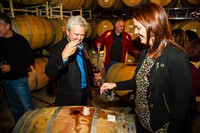 In my post on Demystifying Wine Aromas, I mentioned that smell – not taste – is the human sense that defines the overall flavor of wine. And I spoke about the Middle Ridge Signature Aroma Table – a smell-able display of aroma “reference standards” that are typically used to train wine competition judges and wine writers. I prepare the Aroma Table every year to help guests at our Annual Barrel Tasting learn to identify aromas in wine and develop an understanding of what they enjoy. The table contains over 40 aroma samples – everything from black cherries, nutmeg, and tobacco in red wine to pears, lime and grapefruit in white wines.
In my post on Demystifying Wine Aromas, I mentioned that smell – not taste – is the human sense that defines the overall flavor of wine. And I spoke about the Middle Ridge Signature Aroma Table – a smell-able display of aroma “reference standards” that are typically used to train wine competition judges and wine writers. I prepare the Aroma Table every year to help guests at our Annual Barrel Tasting learn to identify aromas in wine and develop an understanding of what they enjoy. The table contains over 40 aroma samples – everything from black cherries, nutmeg, and tobacco in red wine to pears, lime and grapefruit in white wines.
The Signature Aroma Table has been a huge hit year after year. Guests enjoyed it so much – especially when they had one of those “Aha!” moments – that I wanted to do more to enhance their learning experience. And that’s why I expanded the table to include oak aroma samples.
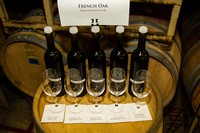 The first addition to the table was five samples of wine aged in French oak. Each sample represents a different toasting level on the inside of the barrel – light, light+, medium, medium+, and heavy. (Winemakers get to choose the toasting level when buying barrels.)
The first addition to the table was five samples of wine aged in French oak. Each sample represents a different toasting level on the inside of the barrel – light, light+, medium, medium+, and heavy. (Winemakers get to choose the toasting level when buying barrels.)
It was so much fun to see the looks of surprise when guests smelled the samples and realized how much barrel toasting impacts the aroma of wine. These are definitely good students, so I couldn’t stop there. The following year, I added a set of American oak samples. Now guests could experience not only the impact of toasting levels but the differences in the type of oak used as well. Wow, this was fun!
So what is it that folks experience? Here’s some interesting info on what happens to wine aromas the longer a barrel is toasted:
- Wine aged in a lightly toasted barrel retains some of the fresh wood aromas of the barrel.
- As a barrel is toasted longer, the fresh wood aromas diminish and sweeter, sugary aromas from the wood such as butter, caramel and vanilla increase.
- At higher toast levels, these aromas are replaced with darker, earthier aromas such as spice, smoke, tobacco, and coffee.
And what about the differences between French and American oak?
FRENCH OAK is a much tighter grain than American oak. As such, the aromas imparted by a French oak barrel are more subtle, which allows those of the grape varietal to be more noticeable. In addition to a perceived aromatic sweetness, common descriptors for wines aged in French oak are fruity, cinnamon and allspice along with chocolate, smoky and coffee.
AMERICAN OAK, with its wider grain, tends to impart stronger, more obvious and sweeter aromas. Common descriptors for American oak are vanilla, honey, butterscotch, coconut, sweet spices and dill. Aromas of pine, resin, and cedar are also associated with American oak.
From the winemaker’s perspective, a wine barrel is never “just” a barrel but a powerful took in the winemaker’s arsenal. I actually think of them as my spice boxes. I use them to season wine in much the same way that I use spices to season food when I’m cooking.
Winemakers usually have a strong preference for the kind of oak and the toasting level used to make their barrels. I certainly do! I use French oak – and a medium or medium+ toast – exclusively because I like the way it works in subtle ways to enhance the natural fruit aromas of the wine. In my opinion, American oak tends to overpower the beauty of the fruit. But, like I said, that’s my preference. You have yours, too, although you may not know how to describe it or what to look for when you’re shopping for wine. And that’s why I love sharing the experience of our Signature Aroma Table. If you live in Southern California or can make arrangements to be in the area, I hope you’ll join us for our Annual Barrel Tasting and develop a better understanding of what you enjoy in wine … one sniff at a time!
Demystifying Wine Aromas ... One Sniff at a Time
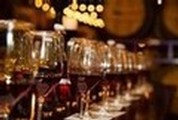

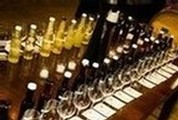
Did you know that smell – not taste – is the human sense that defines the overall flavor of wine? The unfortunate thing is that so many people are unsure of themselves when it comes to identifying aromas in wine and developing an understanding of what they enjoy. In fact, they’re downright uncomfortable with the whole experience. That’s one of the reasons I created the Middle Ridge Signature Aroma Table.
The Signature Aroma Table is an interactive, smell-able display of over 40 aroma “reference standards” that are typically used to train wine competition judges and wine writers. The inspiration for it came from a couple courses Melody and I took at UC-Davis – “Introduction to Sensory Evaluation of Wine” and “Descriptive Analysis of Red and White Table Wine.” They are fantastic two-day seminars that I strongly recommend to everyone. In the second course, we were introduced to over 200 aroma standards that mimic what you smell in wine. It was so much fun that I wanted to share the experience with our club members and friends.
Making the aroma standards is a lot of work, though, so I make just a few dozen for the interactive display at our Annual Barrel Tasting. I start with a cheap wine that has little aroma of its own – but it’s important for its alcohol content. I pour the wine into small bottles and then add a single ingredient to each bottle based on the “recipes” developed at UC-Davis. The alcohol in the base wine volatilizes – turns into vapor – the ingredients that are added to it. So, for instance, I’ll add something like juice from a fresh grapefruit to a bottle of white wine, or pureed black cherries to a bottle with red wine. As the ingredient sits in the wine for a couple days, the aromas are extracted and really start to pop. Once the aromas are fully extracted, I strain any solids out of the sample and it’s ready to go!
Although the aroma standards are made from fruit and other ingredients, the aromas naturally occurring in wine are the result of the entire winemaking process. It starts in the vineyards with the soil and climate. For example, the smell of olives is very common in Temecula Valley Cabernet Sauvignon – it’s just something about the area. And then there’s the fermentation process. All kinds of things can happen there. For starters, there are hundreds of strains of yeast that can be used, and each brings out a different aroma from the grapes. The barrel in which a wine is aged affects the aromas, too. Winemakers love to play around with all these things.
If you like the idea of learning about wine aromas and live in Southern California, be sure to join us for our Annual Barrel Tasting event. The Middle Ridge Signature Aroma Table is one of the highlights of the evening, and it’s a lot of fun! You start by getting a glass of wine and then head over to the Aroma Table. I recommend smelling a few of the aroma standards before sniffing your glass of Middle Ridge. Go back and forth, sniffing the aroma standards and comparing them to your own glass of wine. And before you know it, you’ll have an “Aha!” moment and be able to identify some of the aromas in the wine you’re drinking.
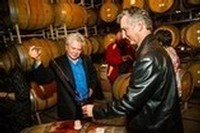
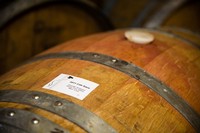
Anyone can develop a good “wine nose.” The trick is to smell things whenever possible – smell the produce at the grocery store, sniff the herbs while you’re cooking, smell the flowers in the garden. It’s important to exercise the nose as much as possible. Your brain will store all these impressions even though you’re not consciously aware of it. Just keep working at it, and one day you’ll surprise yourself – and your friends – and start calling out wine aromas!
* * * * *
What can you expect to smell in wine? Check out the Wine Aroma Wheel created by Wine Folly.
Original Source: Wine Aroma Wheel by Wine Folly
Our Red Takes Home a Gold
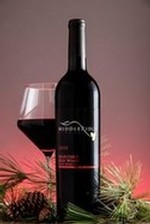 Our 2010 Meritage made from Paso Robles grapes was released just a few months ago, and I’m happy to announce that it’s already racking up awards—most recently it won a Gold Medal at the Long Beach Grand Cru. We call it our yum-yum juice, and it seems the judges think so, too. Not a surprise, really, since Meritage has always been one of our signature wines.
Our 2010 Meritage made from Paso Robles grapes was released just a few months ago, and I’m happy to announce that it’s already racking up awards—most recently it won a Gold Medal at the Long Beach Grand Cru. We call it our yum-yum juice, and it seems the judges think so, too. Not a surprise, really, since Meritage has always been one of our signature wines.
This Bordeaux blend, so called because it’s made from grape varietals from the Bordeaux region of France, consists of Merlot, Cabernet Franc and Cabernet Sauvignon … heavy on the Merlot.
Here’s a fun fact: A red Meritage must be made from a blend of at least two of the following varietals: Cabernet Sauvignon, Merlot, Cabernet Franc, Malbec, Petit Verdot, and the rarer Carmenère, Gros Verdot and St. Macaire. None of these varietals can comprise more than 90% of the blend, and no other varietals can be used in the blend.
By the way, did you ever wonder if you’re pronouncing the word Meritage correctly? It’s really easy to remember the correct pronunciation. Just think of the word heritage. The word Meritage is actually a combination of the words “merit” and “heritage” and is the result of an international contest – with 6,000 entries! – held in the late 1980s by the Meritage Alliance. These American winemakers joined forces and held the competition to create a name that would identify wines blended in the tradition of Bordeaux. Why didn’t they just call their wine a Bordeaux? Good question. Wineries outside of Bordeaux, France are prevented from doing so based on an international agreement. Now there’s an interesting tidbit!
Another thing most folks don’t know is that most wines are blends. The label may say Cabernet Sauvignon, Merlot, what have you, but that doesn’t necessarily mean the bottle contains 100% of that particular varietal. The government has specific guidelines on wine labeling. For example, a wine must be made from at least 75% Cabernet Sauvignon in order to label it as a Cabernet Sauvignon. The remaining 25% can be whatever grape the winemaker wants to use to bring out the best notes of the Cab Sauv.
But back to the Meritage … Another fun fact: I like to age my reds for at least 24 months in French oak. This one was aged exceptionally long – for a full 39 months! Yep, that’s a long time. But the result is a beautiful, rich wine with lots of ripe plum and juicy blackberry aromas that morph into cherries. With just the right amount of acid and a smooth tannin structure, it’s a delight to drink alone or to pair with red meat dishes like roast beef or barbeque tri-tip.
One sip and I’m willing to bet that you’ll feel that our Meritage is worth the wait!
Getting to Know Petit Verdot
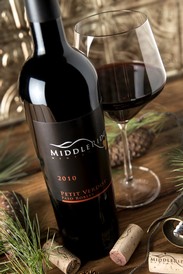 It seems very few people have had the good fortune of tasting and appreciating a Petit Verdot. That’s because few winemakers attempt making it – the grapes produce a wine that is typically coarse, tannic and hard to drink. However, mine has nice bright acids, smooth tannins and is really delicious.
It seems very few people have had the good fortune of tasting and appreciating a Petit Verdot. That’s because few winemakers attempt making it – the grapes produce a wine that is typically coarse, tannic and hard to drink. However, mine has nice bright acids, smooth tannins and is really delicious.
The name Petit Verdot means “small green” and is actually the reason this grape is difficult to grow in its home region of Bordeaux. Unless weather conditions are perfect during flowering, the berries won’t develop, and they remain small. It also tends to ripen later than other Bordeaux varietals, which means that in some years the entire crop is lost. As a result, many French growers uprooted their Petit Verdot plants in the 1960’s in favor of the easier-to-grow Cabernet and Merlot. However, the 1980’s saw a resurgence of Petit Verdot when viticulturists in the U.S., Australia and Argentina discovered that the grape grows really well in the right climate.
I can’t wait for you to try my Petit Verdot. It just may become one of your favorites!
Blog
Recent Posts
-
October 21, 2016
-
October 1, 2016
-
October 22, 2015
-
August 13, 2015(2 Comments)
-
June 30, 2015
-
June 29, 2015(2 Comments)
-
May 19, 2015
-
May 18, 2015
-
November 3, 2014
-
November 1, 2014
Blog Categories
- Events (3)
- Food & Friends (4)
- Idyllwild (1)
- Just For Fun (1)
- Special Offers (1)
- Wine (9)
- Winemaking (1)

